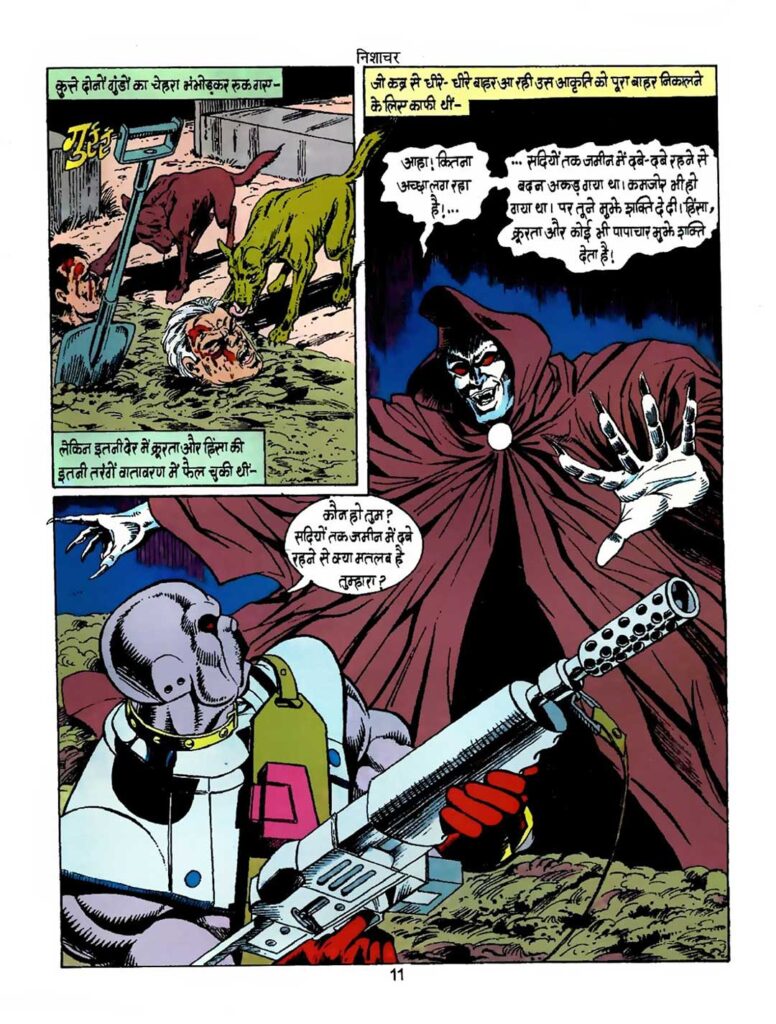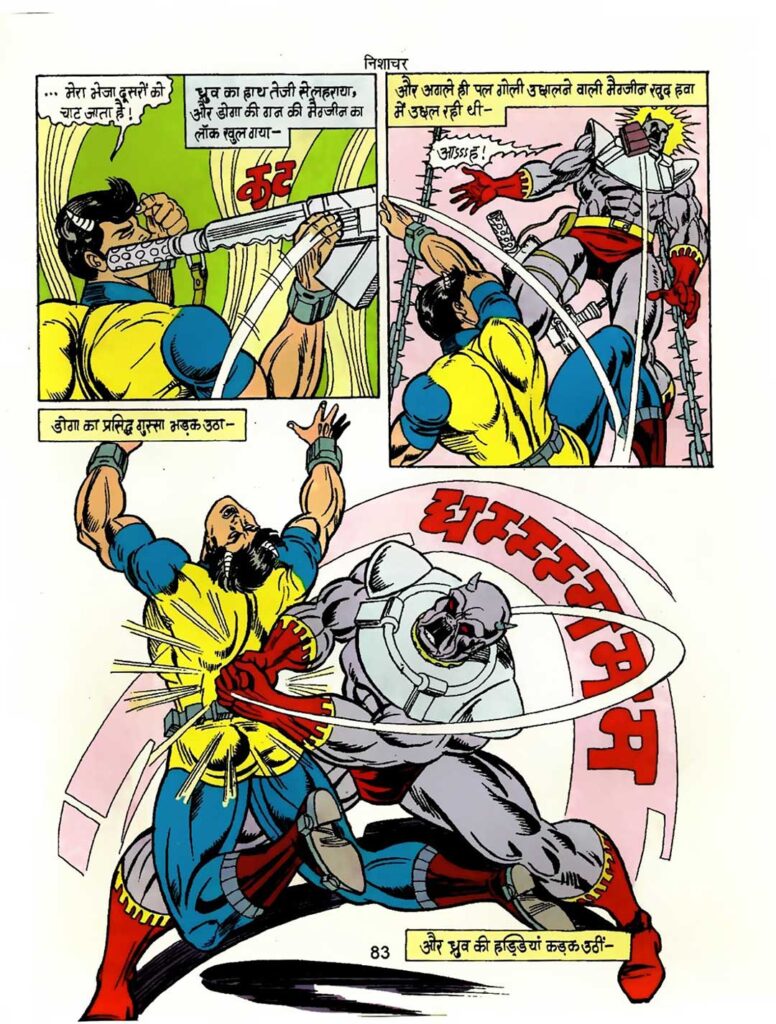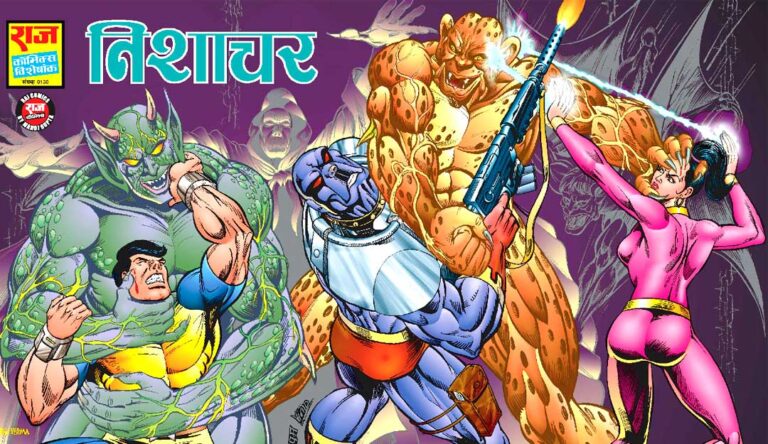‘Nishachar (Nocturnal)’ is not just a comic, but an epic narrative that takes the eternal struggle of good and evil to a new and philosophical ground. This story, from the pen of Jolly Sinha and the illustrations of Anupam Sinha, brought to life together with Kuchi, provides an experience that leaves a deep impression on the minds of the readers. ‘Nishachar (Nocturnal)’ is a multi-starrer special issue, in which two of Raj Comics’ biggest and ideologically opposite heroes – Super Commando Dhruv and Doga – come together, making this comic even more special.
This story raises the fundamental question of whether the cruelty adopted to eliminate evil can itself lead to a greater evil. Is the reward of our deeds limited only to the material world, or does it also affect the spiritual and transcendental powers? ‘Nishachar (Nocturnal)’ is a memorable saga woven into the fabric of these complex questions.
Plot: When violence called for a monster
The plot of ‘Nishachar (Nocturnal)’ may seem like a superhero versus demon battle on the surface, but its roots are very deep. The story begins in the dark streets of Mumbai, which is the workplace of Doga. A social activist, David, raises his voice against the hafta-recovery terror of mafia don ‘Chhote Haji’, and is brutally killed. The horror of the mafia is so great that no one dares to cremate David. In such a situation, when some of David’s friends and relatives fearfully come to an old cemetery in Bandra to bury him, Chhote Haji’s goons reach there and prepare to bury those innocent people alive.
It is here that Doga, the most dreaded guardian of Mumbai’s law, enters. Doga, in his familiar style, wreaks havoc on those goons. He does not just kill them, but demonstrates the height of his cruelty – breaking bones, making them scream, and finally burying them in the ground up to their necks. Doga believes that showing kindness towards crime and criminals is the biggest sin. But he is unaware that his horrific violence is energizing an ancient and vengeful force buried in that cemetery. The land of that graveyard is absorbing the waves of hatred, violence, pain, and negativity spread by Doga and germinating a seed that will soon appear as a terrible monster – the Nishachar.

As Doga’s ‘justice’ continues in Mumbai, the power of the Nishachar in the cemetery increases. He breathes life into David’s dead body, making him his puppet, and then clashes with Doga. Doga, who had fought criminals until now, encounters for the first time a supernatural force that is beyond the reach of his physical strength and weapons. The source of Nishachar’s strength is not material, but spiritual – it is nourished by hatred. The more anger and violence Doga uses, the more powerful the Nishachar becomes.
The other end of the story connects with Super Commando Dhruv in Rajnagar. Super Commando Dhruv meets expert Dayayogi, who tells him about a Shastrakavach carved on an ancient stone. Dayayogi explains that this story is about three hundred and fifty years old, when unrighteousness started weighing heavily on religion in the world. At that time, the animalistic tendencies (asuri qualities) within humans were dominating their divine tendencies. Due to this increasing negativity and sin, the foundation for the birth of Nishachar was laid. Dayayogi further explains that Nishachar is not a single person or demon, but a power born from the collective energy of sin, hatred, and violence of the entire world. The accomplished Mahayogis of that era had already sensed this terrible rise of Nishachar. They contacted the monks of the next world and prepared to stop the creature even before its birth.
When the terror of Nishachar starts spreading from Mumbai to the entire country, Dhruv sets out to solve this puzzle. The investigation brings him to Doga, and it is here that the two greatest heroes of Raj Comics clash and then unite. Dhruv, with his scientific thinking and calm nature, understands that Nishachar cannot be defeated by physical force. To defeat him, his source of power – that is, hatred and violence – must be cut off. In the climax of the story, other heroes like Dhruv, Doga, Shakti, and Nagraj also join this fight, and together they fight not only Nishachar, but also the ideology that gives birth to it.
The biggest strength of ‘Nishachar (Nocturnal)’ is the powerful portrayal of its characters, especially Doga and Dhruv.
Doga: The untold hero and villain of this story, Doga fights against injustice, but his methods are so cruel that they themselves begin to touch upon the definition of injustice. The comic shows that Doga’s ‘Instant Justice’ model may create fear among criminals, but it also adds deep negativity to society. The birth of Nishachar is an indirect result of this functioning of Doga. The character presents a complex moral dilemma as to whether the goal can justify the means.

Super Commando Dhruv: Dhruv embodies balance and sanity in the story. He regards violence as a last resort, unlike Doga. His power lies in his intelligence, strategy, and positive attitude. He understands that Nishachar is not just a monster, but a reflection of the evil growing within humanity. Dhruv’s character conveys the message that real victory is not achieved by weapons, but by eliminating the hatred growing in hearts.
Nishachar: He is not just a monster, but a concept. He has no past, no personal ambitions. He is only the embodiment of hatred, anger, and violence. The more frightening he looks, the more philosophical his existence is. He symbolizes that when humanity falls from its values, it gives birth to demons for its own destruction.
Art and Painting: The Magic of Anupam Sinha
If Jolly Sinha’s story is the soul of Nishachar, then Anupam Sinha’s portrayal is its body. Anupam Sinha is one of the best comics artists of India, and Nishachar is one of the top works of his career.

The action sequences in Nishachar are no less than a Hollywood blockbuster. These scenes, filled with the terror of Doga’s cruelty and Nishachar’s menace, clearly reflect the speed and energy in each panel, where Anupam Sinha has accurately captured the body language and emotions of the characters. The Nishachar design is also extremely frightening — a giant, bat-winged creature whose eyes show only darkness, sending shivers down the reader’s spine. Along with this, Doga’s muscular build and Dhruv’s athletic build perfectly reflect their personalities. Sinha not only creates pictures, he also creates atmosphere. There is a deep, dark, and gothic feel to scenes like Mumbai’s graveyard and Nishachar’s attack. Sunil Pandey’s use of colors in these scenes, especially the play between darkness and light, plays an important role in setting the mood of the story.
A Commentary on the Philosophy of Violence
Nishachar is a comic far ahead of its time. It does not just entertain, but also makes the reader think. Nishachar highlights many deep themes. Its central message is that the cycle of violence only leads to more violence; Doga’s cruelty created Nishachar, and more violence had to be resorted to in order to eliminate it — a vicious cycle that is almost impossible to break. The story also shows the power of faith and positivity, where in the end the heroes understand that Nishachar can be weakened only by positive energy, hope, and faith. It is a modern form of the battle between ‘righteousness’ and ‘unrighteousness’ in Indian philosophy. Furthermore, the story also makes social commentary, highlighting the mafia rule of Mumbai and the failure of the system, creating a fertile environment for violent messiahs like Doga and demons like Nishachar.
Conclusion: A Timeless Classic
Nishachar is a milestone in the history of Raj Comics. It is a comic that is as relevant today as it was at the time of its publication. It is a perfect balance of story, art, action, and philosophy. It’s not just a superhero story, but a mirror of our society and our own conscience. It reminds us that real demons do not dwell outside, but in the hatred, anger, and intolerance that flourish within us.
This jugalbandi of Jolly Sinha and Anupam Sinha creates a work that every comics lover must read. If you want to understand the potential and depth of Indian comics, Nishachar is a perfect starting point for you. It is a dark, intense, and thought-provoking story that proves the medium of comics can effectively present serious and mature themes, going far beyond mere children’s entertainment.
